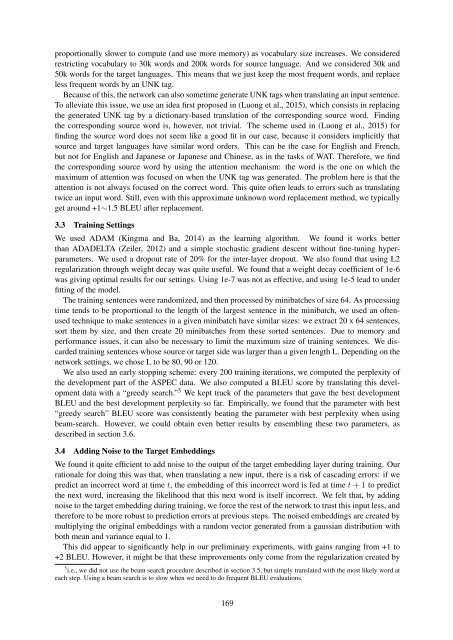December 11-16 2016 Osaka Japan
W16-46
W16-46
You also want an ePaper? Increase the reach of your titles
YUMPU automatically turns print PDFs into web optimized ePapers that Google loves.
proportionally slower to compute (and use more memory) as vocabulary size increases. We considered<br />
restricting vocabulary to 30k words and 200k words for source language. And we considered 30k and<br />
50k words for the target languages. This means that we just keep the most frequent words, and replace<br />
less frequent words by an UNK tag.<br />
Because of this, the network can also sometime generate UNK tags when translating an input sentence.<br />
To alleviate this issue, we use an idea first proposed in (Luong et al., 2015), which consists in replacing<br />
the generated UNK tag by a dictionary-based translation of the corresponding source word. Finding<br />
the corresponding source word is, however, not trivial. The scheme used in (Luong et al., 2015) for<br />
finding the source word does not seem like a good fit in our case, because it considers implicitly that<br />
source and target languages have similar word orders. This can be the case for English and French,<br />
but not for English and <strong>Japan</strong>ese or <strong>Japan</strong>ese and Chinese, as in the tasks of WAT. Therefore, we find<br />
the corresponding source word by using the attention mechanism: the word is the one on which the<br />
maximum of attention was focused on when the UNK tag was generated. The problem here is that the<br />
attention is not always focused on the correct word. This quite often leads to errors such as translating<br />
twice an input word. Still, even with this approximate unknown word replacement method, we typically<br />
get around +1∼1.5 BLEU after replacement.<br />
3.3 Training Settings<br />
We used ADAM (Kingma and Ba, 2014) as the learning algorithm. We found it works better<br />
than ADADELTA (Zeiler, 2012) and a simple stochastic gradient descent without fine-tuning hyperparameters.<br />
We used a dropout rate of 20% for the inter-layer dropout. We also found that using L2<br />
regularization through weight decay was quite useful. We found that a weight decay coefficient of 1e-6<br />
was giving optimal results for our settings. Using 1e-7 was not as effective, and using 1e-5 lead to under<br />
fitting of the model.<br />
The training sentences were randomized, and then processed by minibatches of size 64. As processing<br />
time tends to be proportional to the length of the largest sentence in the minibatch, we used an oftenused<br />
technique to make sentences in a given minibatch have similar sizes: we extract 20 x 64 sentences,<br />
sort them by size, and then create 20 minibatches from these sorted sentences. Due to memory and<br />
performance issues, it can also be necessary to limit the maximum size of training sentences. We discarded<br />
training sentences whose source or target side was larger than a given length L. Depending on the<br />
network settings, we chose L to be 80, 90 or 120.<br />
We also used an early stopping scheme: every 200 training iterations, we computed the perplexity of<br />
the development part of the ASPEC data. We also computed a BLEU score by translating this development<br />
data with a “greedy search.” 5 We kept track of the parameters that gave the best development<br />
BLEU and the best development perplexity so far. Empirically, we found that the parameter with best<br />
“greedy search” BLEU score was consistently beating the parameter with best perplexity when using<br />
beam-search. However, we could obtain even better results by ensembling these two parameters, as<br />
described in section 3.6.<br />
3.4 Adding Noise to the Target Embeddings<br />
We found it quite efficient to add noise to the output of the target embedding layer during training. Our<br />
rationale for doing this was that, when translating a new input, there is a risk of cascading errors: if we<br />
predict an incorrect word at time t, the embedding of this incorrect word is fed at time t + 1 to predict<br />
the next word, increasing the likelihood that this next word is itself incorrect. We felt that, by adding<br />
noise to the target embedding during training, we force the rest of the network to trust this input less, and<br />
therefore to be more robust to prediction errors at previous steps. The noised embeddings are created by<br />
multiplying the original embeddings with a random vector generated from a gaussian distribution with<br />
both mean and variance equal to 1.<br />
This did appear to significantly help in our preliminary experiments, with gains ranging from +1 to<br />
+2 BLEU. However, it might be that these improvements only come from the regularization created by<br />
5 i.e., we did not use the beam search procedure described in section 3.5, but simply translated with the most likely word at<br />
each step. Using a beam search is to slow when we need to do frequent BLEU evaluations.<br />
<strong>16</strong>9



